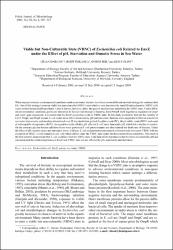Viable but Non-Culturable State (VBNC) of Escherichia coli Related to EnvZ under the Effect of pH, Starvation and Osmotic Stress in Sea Water

View/
xmlui.dri2xhtml.METS-1.0.item-rights
info:eu-repo/semantics/openAccessDate
2009Metadata
Show full item recordAbstract
When exposed extreme environmental conditions such as sea water, bacteria have been shown different survival strategy for continue their life. One of this strategy known as viable but nonculturable (VBNC) state which is very important for nondifferiation bacteria. VBNC cells cause serious human health problems. Little is known, however, about the genetic mechanisms underlying the VBNC state. Under different environmental conditions, porins are important in the survival strategy of bacteria. EnvZ/OmpR work together as regulators of ompF and ompC gene expression. It is known that the EnvZ system has a role in VBNC state. In this study we tried to find out the viability of EnvZ, OmpC and OmpF mutant E. coli under stress effect of osmolarity, pH and starvation. Bacteria were suspended in filtered-autoclaved sea water microcosms and numbers determined over 25 day incubation periods by plate count (PC), direct viable count (DVC) and count of cells capable of respiration (RCC). As regard to results, alkaline pH affected E. coli more than acidic pH, which led to decline in number. On the contrary glycine betaine addition to sea water protected E. coli porin mutants and also reduced the death rate of bacteria. Under the effect of pH, osmotic stress and starvation stress, wild type E. coli and porin mutants entered a dormant state or became VBNC with the exception of MSZ31 (envZ mutant) E.coli cells which did not enter the VBNC state under the three tested stress conditions. This study is the first report to demonstrate that E. coli could not enter the VBNC state in the lick of EnvZ product under the stress of osmolarity, pH and starvation and the relationship between EnvZ and VBNC state are not affected by pH, osmolarity and starvation.

















